Essay on Organizational Behavior: Enhancing Productive Performance
VerifiedAdded on 2020/05/16
|11
|2426
|56
Essay
AI Summary
This essay delves into the multifaceted concept of organizational behavior, emphasizing its critical role in enhancing productive performance within a workplace setting. It meticulously examines the influence of key factors such as job design, working conditions, goal setting, motivation, and rewards on employee output. The essay underscores the significance of a productive workforce in achieving company objectives, including superior customer service, investment goal attainment, and increased employee satisfaction. It provides a comprehensive analysis of how these factors contribute to overall organizational success, evaluating the impact of various organizational behavior theories and how managers can effectively leverage these theories to improve the work environment. The essay explores the impact of job design on motivation, the importance of working conditions, and the role of rewards and goal setting in fostering a high-performing workforce. The essay also reviews existing literature to support the arguments, including the application of the Vroom's expectancy theory and Herzberg's motivation-hygiene theory. The conclusion summarizes the key findings, reinforcing the idea that a motivated and satisfied workforce is essential for a company's success. The essay provides valuable insights for managers seeking to influence and improve productive performance within their organizations.
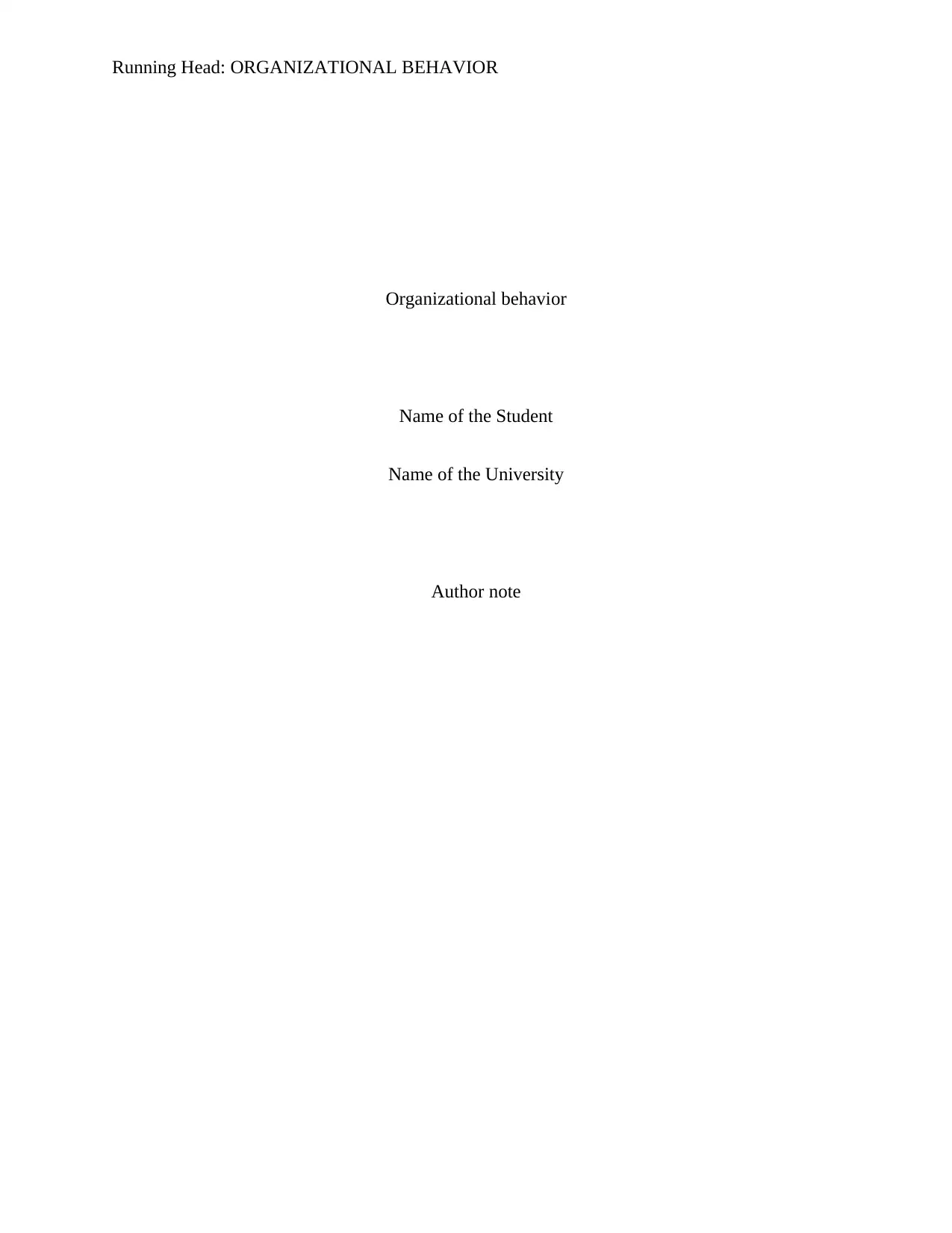
Running Head: ORGANIZATIONAL BEHAVIOR
Organizational behavior
Name of the Student
Name of the University
Author note
Organizational behavior
Name of the Student
Name of the University
Author note
Paraphrase This Document
Need a fresh take? Get an instant paraphrase of this document with our AI Paraphraser
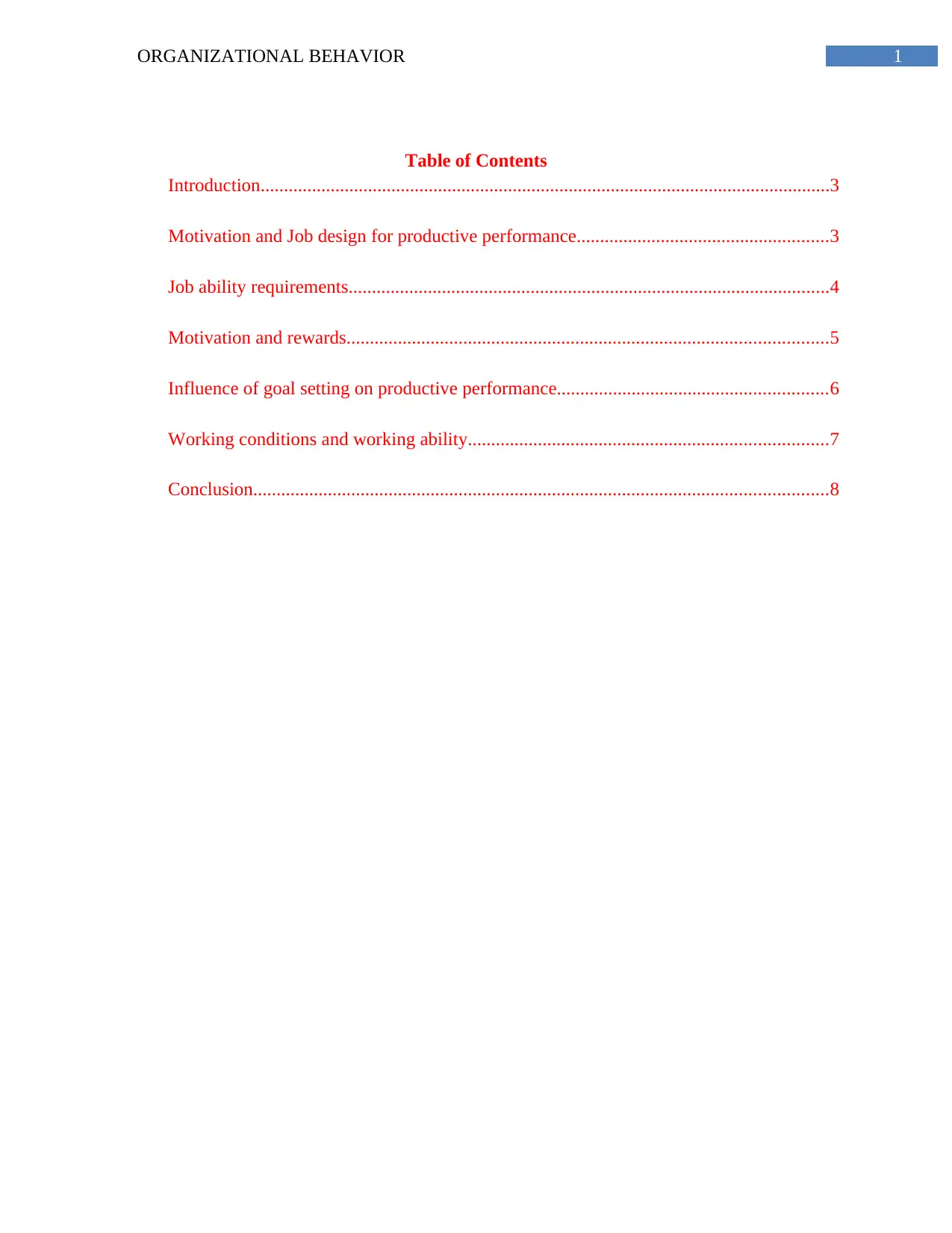
1ORGANIZATIONAL BEHAVIOR
Table of Contents
Introduction..........................................................................................................................3
Motivation and Job design for productive performance......................................................3
Job ability requirements.......................................................................................................4
Motivation and rewards.......................................................................................................5
Influence of goal setting on productive performance..........................................................6
Working conditions and working ability.............................................................................7
Conclusion...........................................................................................................................8
Table of Contents
Introduction..........................................................................................................................3
Motivation and Job design for productive performance......................................................3
Job ability requirements.......................................................................................................4
Motivation and rewards.......................................................................................................5
Influence of goal setting on productive performance..........................................................6
Working conditions and working ability.............................................................................7
Conclusion...........................................................................................................................8

2ORGANIZATIONAL BEHAVIOR
Introduction
The essay deals with the concept the organisation behaviour. In any organisation the
productive performance is enhanced by taking the care needs such as design of jobs, working
conditions, setting of goals, motivation and rewards. Productive performance is important in
workplace. It translates into good customer service, accomplishment of investment goals, and
increase workforce satisfaction. A productive workforce leads to successful company. Being
productive ensures the company to utilise the human resource capacity to its fullest (Cording, et
al., 2014). In this context the essay aims to explain how and why all these factors impact upon
productive performance. Further, the essay evaluates how a manager may be able to impact upon
the processes across the organisation.
Motivation and Job design for productive performance
Motivation is an important factor in any organisation. An employee’s performance is
influenced by the job design, work environment, setting of goals, and ability. A well motivated
workforce resembles productive workforce (Lazaroiu, 2015). Job design significantly impacts an
employee motivation. Employees are motivated, if the tasks created are challenging and
interesting. If the tasks are standardised then it becomes mundane. Job enlargement is the
strategy used by mangers to introduce variation in task. Another strategy used is job enrichment,
in which actual job is enhanced by motivating employees through several factors (Parker, 2014).
The efficacy of job design method in fostering employee motivation is evident from both old and
new literature on organisational behaviour. According to Tims, Derks and Bakker (2016), a job
design with motivational features was found to lower the efforts of the employees, stress and
increase their well-being. Job designs that scored high on the motivational scale, highlighted,
Introduction
The essay deals with the concept the organisation behaviour. In any organisation the
productive performance is enhanced by taking the care needs such as design of jobs, working
conditions, setting of goals, motivation and rewards. Productive performance is important in
workplace. It translates into good customer service, accomplishment of investment goals, and
increase workforce satisfaction. A productive workforce leads to successful company. Being
productive ensures the company to utilise the human resource capacity to its fullest (Cording, et
al., 2014). In this context the essay aims to explain how and why all these factors impact upon
productive performance. Further, the essay evaluates how a manager may be able to impact upon
the processes across the organisation.
Motivation and Job design for productive performance
Motivation is an important factor in any organisation. An employee’s performance is
influenced by the job design, work environment, setting of goals, and ability. A well motivated
workforce resembles productive workforce (Lazaroiu, 2015). Job design significantly impacts an
employee motivation. Employees are motivated, if the tasks created are challenging and
interesting. If the tasks are standardised then it becomes mundane. Job enlargement is the
strategy used by mangers to introduce variation in task. Another strategy used is job enrichment,
in which actual job is enhanced by motivating employees through several factors (Parker, 2014).
The efficacy of job design method in fostering employee motivation is evident from both old and
new literature on organisational behaviour. According to Tims, Derks and Bakker (2016), a job
design with motivational features was found to lower the efforts of the employees, stress and
increase their well-being. Job designs that scored high on the motivational scale, highlighted,
⊘ This is a preview!⊘
Do you want full access?
Subscribe today to unlock all pages.

Trusted by 1+ million students worldwide
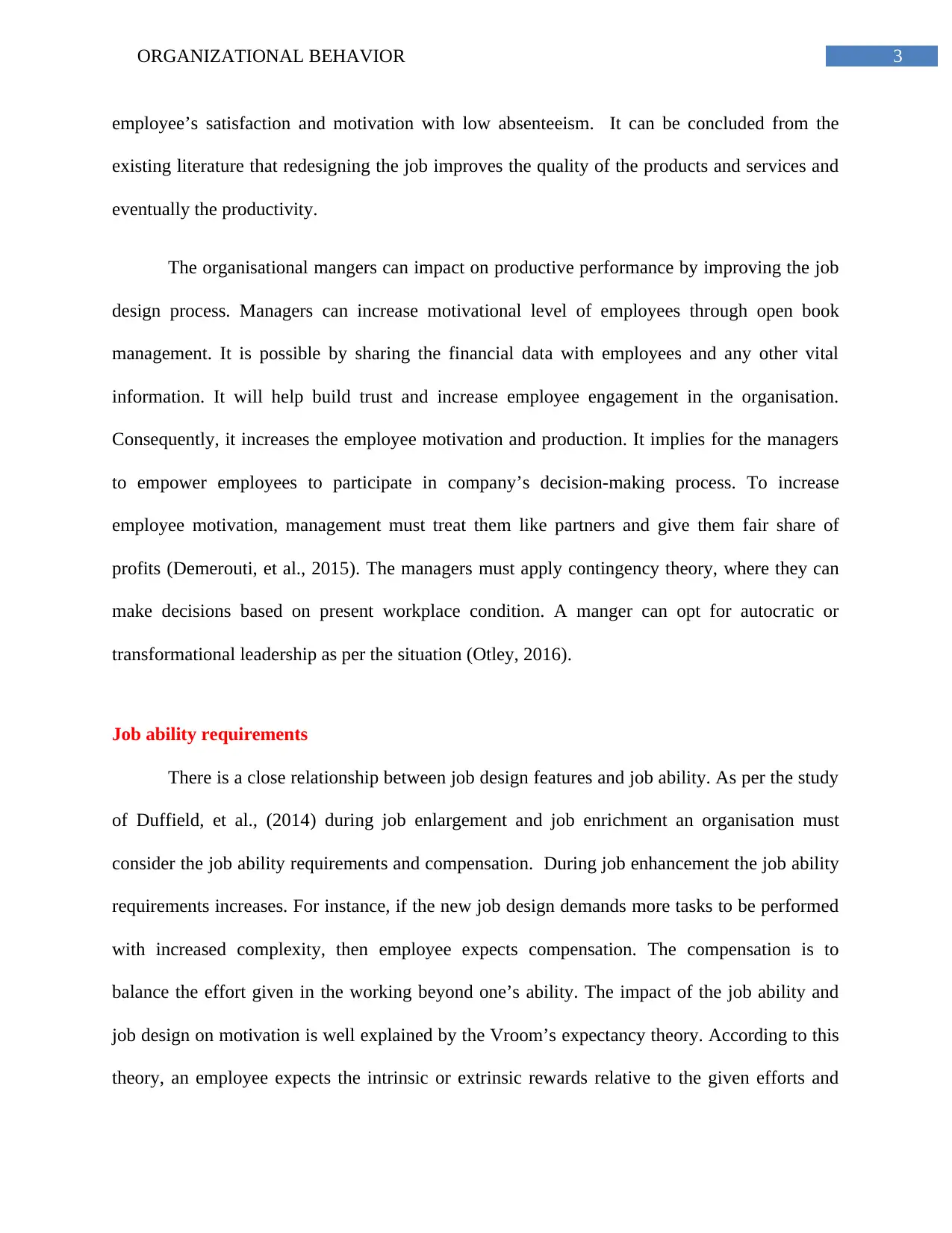
3ORGANIZATIONAL BEHAVIOR
employee’s satisfaction and motivation with low absenteeism. It can be concluded from the
existing literature that redesigning the job improves the quality of the products and services and
eventually the productivity.
The organisational mangers can impact on productive performance by improving the job
design process. Managers can increase motivational level of employees through open book
management. It is possible by sharing the financial data with employees and any other vital
information. It will help build trust and increase employee engagement in the organisation.
Consequently, it increases the employee motivation and production. It implies for the managers
to empower employees to participate in company’s decision-making process. To increase
employee motivation, management must treat them like partners and give them fair share of
profits (Demerouti, et al., 2015). The managers must apply contingency theory, where they can
make decisions based on present workplace condition. A manger can opt for autocratic or
transformational leadership as per the situation (Otley, 2016).
Job ability requirements
There is a close relationship between job design features and job ability. As per the study
of Duffield, et al., (2014) during job enlargement and job enrichment an organisation must
consider the job ability requirements and compensation. During job enhancement the job ability
requirements increases. For instance, if the new job design demands more tasks to be performed
with increased complexity, then employee expects compensation. The compensation is to
balance the effort given in the working beyond one’s ability. The impact of the job ability and
job design on motivation is well explained by the Vroom’s expectancy theory. According to this
theory, an employee expects the intrinsic or extrinsic rewards relative to the given efforts and
employee’s satisfaction and motivation with low absenteeism. It can be concluded from the
existing literature that redesigning the job improves the quality of the products and services and
eventually the productivity.
The organisational mangers can impact on productive performance by improving the job
design process. Managers can increase motivational level of employees through open book
management. It is possible by sharing the financial data with employees and any other vital
information. It will help build trust and increase employee engagement in the organisation.
Consequently, it increases the employee motivation and production. It implies for the managers
to empower employees to participate in company’s decision-making process. To increase
employee motivation, management must treat them like partners and give them fair share of
profits (Demerouti, et al., 2015). The managers must apply contingency theory, where they can
make decisions based on present workplace condition. A manger can opt for autocratic or
transformational leadership as per the situation (Otley, 2016).
Job ability requirements
There is a close relationship between job design features and job ability. As per the study
of Duffield, et al., (2014) during job enlargement and job enrichment an organisation must
consider the job ability requirements and compensation. During job enhancement the job ability
requirements increases. For instance, if the new job design demands more tasks to be performed
with increased complexity, then employee expects compensation. The compensation is to
balance the effort given in the working beyond one’s ability. The impact of the job ability and
job design on motivation is well explained by the Vroom’s expectancy theory. According to this
theory, an employee expects the intrinsic or extrinsic rewards relative to the given efforts and
Paraphrase This Document
Need a fresh take? Get an instant paraphrase of this document with our AI Paraphraser

4ORGANIZATIONAL BEHAVIOR
level of performance achieved (Parijat and Bagga, 2014). If the compensation or rewards are not
fair it decreases job satisfaction and motivation.
It implies that the managers can apply the Vroom’s theory, to determine the performance
level required to meet the organisational goals. They must ensure that the desired performance
and outcomes are linked. In order to make the total system equitable, the rewards need to be
large enough. Using the system theory, the managers can have a better understanding of ways
employees are influencing the organisation. Eventually, the managers can come up with plans to
develop programs to meet the organisational goals (Hill, Jones and Schilling, 2014).
Motivation and rewards
The system of motivation and rewards both monetary and non-monetary develops the
feeling of achievement among employees. It further, motivates them to work towards the
organisational and personal goals. Rewards like promotions ensure employee satisfaction and
promotes cooperative relationship. It brings stability in the organisation. Stability increases the
feeling of participation in the management. It will increase the productivity and profit
maximisation. Therefore, managers must derive strategies for employee motivation. According
to Hawthorne effect, employees give more productivity, when they are watched and their input is
valued. It also helps others change their behaviour in organisation. Rewards increases
employee’s level of efficiency and puts human resources into action (Zikmund, et al., 2013).
To increase the employee motivation, the management can implement a gain sharing plan
that is beneficial for both employer and employees. The theory of X and Y can better explain
this process. This theory is subjective to the beliefs about the employee attitude. A manager can
use the theory of X if an employee is believed to naturally lack ambition ad may give
level of performance achieved (Parijat and Bagga, 2014). If the compensation or rewards are not
fair it decreases job satisfaction and motivation.
It implies that the managers can apply the Vroom’s theory, to determine the performance
level required to meet the organisational goals. They must ensure that the desired performance
and outcomes are linked. In order to make the total system equitable, the rewards need to be
large enough. Using the system theory, the managers can have a better understanding of ways
employees are influencing the organisation. Eventually, the managers can come up with plans to
develop programs to meet the organisational goals (Hill, Jones and Schilling, 2014).
Motivation and rewards
The system of motivation and rewards both monetary and non-monetary develops the
feeling of achievement among employees. It further, motivates them to work towards the
organisational and personal goals. Rewards like promotions ensure employee satisfaction and
promotes cooperative relationship. It brings stability in the organisation. Stability increases the
feeling of participation in the management. It will increase the productivity and profit
maximisation. Therefore, managers must derive strategies for employee motivation. According
to Hawthorne effect, employees give more productivity, when they are watched and their input is
valued. It also helps others change their behaviour in organisation. Rewards increases
employee’s level of efficiency and puts human resources into action (Zikmund, et al., 2013).
To increase the employee motivation, the management can implement a gain sharing plan
that is beneficial for both employer and employees. The theory of X and Y can better explain
this process. This theory is subjective to the beliefs about the employee attitude. A manager can
use the theory of X if an employee is believed to naturally lack ambition ad may give

5ORGANIZATIONAL BEHAVIOR
productivity by gaining incentives. The mangers may adopt a controlling style of leadership for
this purpose. If the employees are believed to take responsibility without external motivating
factors, then the managers can lean towards theory Y. Using theory Y a mangers motivates and
inspires employees for participation (Arslan and Staub, 2013).
Influence of goal setting on productive performance
Goal setting is essential factor in every organisation. It is the tool to measure the internal
factors like staff expansion, growth and profitability. The benefits of goal setting include
increase in employee focus, group cohesion, and employee worth. Goal-setting allows the
managers to gauge work progress and impact of the efforts (Locke and Latham, 2013). The
relationship between the goal-setting and employee motivation is explained in the study by
Lazaroiu (2015). According to this study, goals give employees the source to strive in their daily
life. Goals give specific standards that constitute success. If goals are tied to external rewards
such as group recognition, it motivates the employees to strive for excellence.
According to the goal setting theory, goals should be set by managers on a regular basis,
and tie up the accomplishment with the rewards. The efficacy of the theory has been supported
by various empirical studies. It is effective than any other single approach. It implies for the
managers to use SMART principle. It stands for “specific, measurable, attainable, relevant and
timely”, to evaluate the work productivity. In this process, the mangers can induce positive
impact by making concerted efforts to build group cohesiveness and protect the employee’s
rights in the organisation (Scobbie, et al., 2013).
productivity by gaining incentives. The mangers may adopt a controlling style of leadership for
this purpose. If the employees are believed to take responsibility without external motivating
factors, then the managers can lean towards theory Y. Using theory Y a mangers motivates and
inspires employees for participation (Arslan and Staub, 2013).
Influence of goal setting on productive performance
Goal setting is essential factor in every organisation. It is the tool to measure the internal
factors like staff expansion, growth and profitability. The benefits of goal setting include
increase in employee focus, group cohesion, and employee worth. Goal-setting allows the
managers to gauge work progress and impact of the efforts (Locke and Latham, 2013). The
relationship between the goal-setting and employee motivation is explained in the study by
Lazaroiu (2015). According to this study, goals give employees the source to strive in their daily
life. Goals give specific standards that constitute success. If goals are tied to external rewards
such as group recognition, it motivates the employees to strive for excellence.
According to the goal setting theory, goals should be set by managers on a regular basis,
and tie up the accomplishment with the rewards. The efficacy of the theory has been supported
by various empirical studies. It is effective than any other single approach. It implies for the
managers to use SMART principle. It stands for “specific, measurable, attainable, relevant and
timely”, to evaluate the work productivity. In this process, the mangers can induce positive
impact by making concerted efforts to build group cohesiveness and protect the employee’s
rights in the organisation (Scobbie, et al., 2013).
⊘ This is a preview!⊘
Do you want full access?
Subscribe today to unlock all pages.

Trusted by 1+ million students worldwide

6ORGANIZATIONAL BEHAVIOR
Working conditions and working ability
In addition to the working ability the employee motivation is also influenced by the
working condition. Working condition is positively related to the employee job satisfaction.
Working conditions refers to shift timings, health and safety, esteem needs, relationship with co-
workers, job safety and top management (Muogbo, 2013). According to Lamba and Choudhary
(2013), poor working conditions limit the workforce to perform to their full potential. Productive
performance was found to increase by developing conducive and friendly workforce in various
sectors like banking and telecommunication. Good working conditions like flexible shift hours
are effective in helping employees maintain work life balance. Employee working condition is
found to be critical to the performance in duties and over all well-being. The review of past
studies reveals that this factor has positive influence on employee performance. It implies for the
managers to develop good working conditions in organisation as the matter of priority.
Mangers can impact on the process of improving factors like working conditions and
working ability for productive performance by providing adequate facilities and quality-of-work-
life programs. It may include developing workplace and family support programs, exercise
facilities, counselling sessions, convenience facilities and others. These strategies in some
organisation led to employee motivation, cost reduction due to absenteeism, reduce health risks
and sick days. They can have an impact in this process by providing and maintaing quality-of-
work-life programs successfully to reduce turnover. Health and safety programs have been found
to reduce the occupational injuries (Muogbo, 2013). Managers involved in this process can gain
competitive edge for the organisation. Improvement in working conditions has led to increase job
satisfaction and improved service levels and consequently productive performance. This process
was also fund to improve the relationship between employees and employers. Implementing the
Working conditions and working ability
In addition to the working ability the employee motivation is also influenced by the
working condition. Working condition is positively related to the employee job satisfaction.
Working conditions refers to shift timings, health and safety, esteem needs, relationship with co-
workers, job safety and top management (Muogbo, 2013). According to Lamba and Choudhary
(2013), poor working conditions limit the workforce to perform to their full potential. Productive
performance was found to increase by developing conducive and friendly workforce in various
sectors like banking and telecommunication. Good working conditions like flexible shift hours
are effective in helping employees maintain work life balance. Employee working condition is
found to be critical to the performance in duties and over all well-being. The review of past
studies reveals that this factor has positive influence on employee performance. It implies for the
managers to develop good working conditions in organisation as the matter of priority.
Mangers can impact on the process of improving factors like working conditions and
working ability for productive performance by providing adequate facilities and quality-of-work-
life programs. It may include developing workplace and family support programs, exercise
facilities, counselling sessions, convenience facilities and others. These strategies in some
organisation led to employee motivation, cost reduction due to absenteeism, reduce health risks
and sick days. They can have an impact in this process by providing and maintaing quality-of-
work-life programs successfully to reduce turnover. Health and safety programs have been found
to reduce the occupational injuries (Muogbo, 2013). Managers involved in this process can gain
competitive edge for the organisation. Improvement in working conditions has led to increase job
satisfaction and improved service levels and consequently productive performance. This process
was also fund to improve the relationship between employees and employers. Implementing the
Paraphrase This Document
Need a fresh take? Get an instant paraphrase of this document with our AI Paraphraser
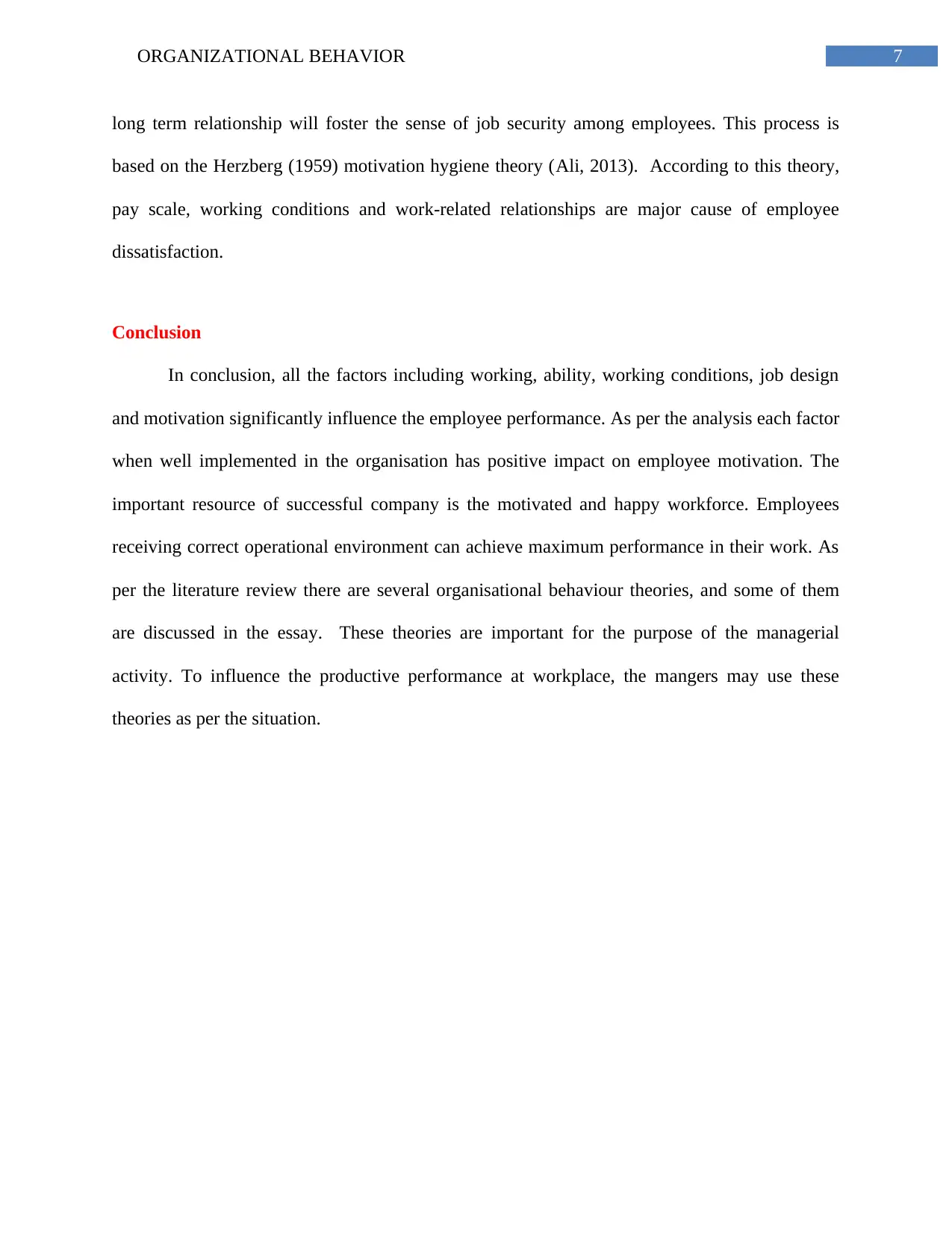
7ORGANIZATIONAL BEHAVIOR
long term relationship will foster the sense of job security among employees. This process is
based on the Herzberg (1959) motivation hygiene theory (Ali, 2013). According to this theory,
pay scale, working conditions and work-related relationships are major cause of employee
dissatisfaction.
Conclusion
In conclusion, all the factors including working, ability, working conditions, job design
and motivation significantly influence the employee performance. As per the analysis each factor
when well implemented in the organisation has positive impact on employee motivation. The
important resource of successful company is the motivated and happy workforce. Employees
receiving correct operational environment can achieve maximum performance in their work. As
per the literature review there are several organisational behaviour theories, and some of them
are discussed in the essay. These theories are important for the purpose of the managerial
activity. To influence the productive performance at workplace, the mangers may use these
theories as per the situation.
long term relationship will foster the sense of job security among employees. This process is
based on the Herzberg (1959) motivation hygiene theory (Ali, 2013). According to this theory,
pay scale, working conditions and work-related relationships are major cause of employee
dissatisfaction.
Conclusion
In conclusion, all the factors including working, ability, working conditions, job design
and motivation significantly influence the employee performance. As per the analysis each factor
when well implemented in the organisation has positive impact on employee motivation. The
important resource of successful company is the motivated and happy workforce. Employees
receiving correct operational environment can achieve maximum performance in their work. As
per the literature review there are several organisational behaviour theories, and some of them
are discussed in the essay. These theories are important for the purpose of the managerial
activity. To influence the productive performance at workplace, the mangers may use these
theories as per the situation.
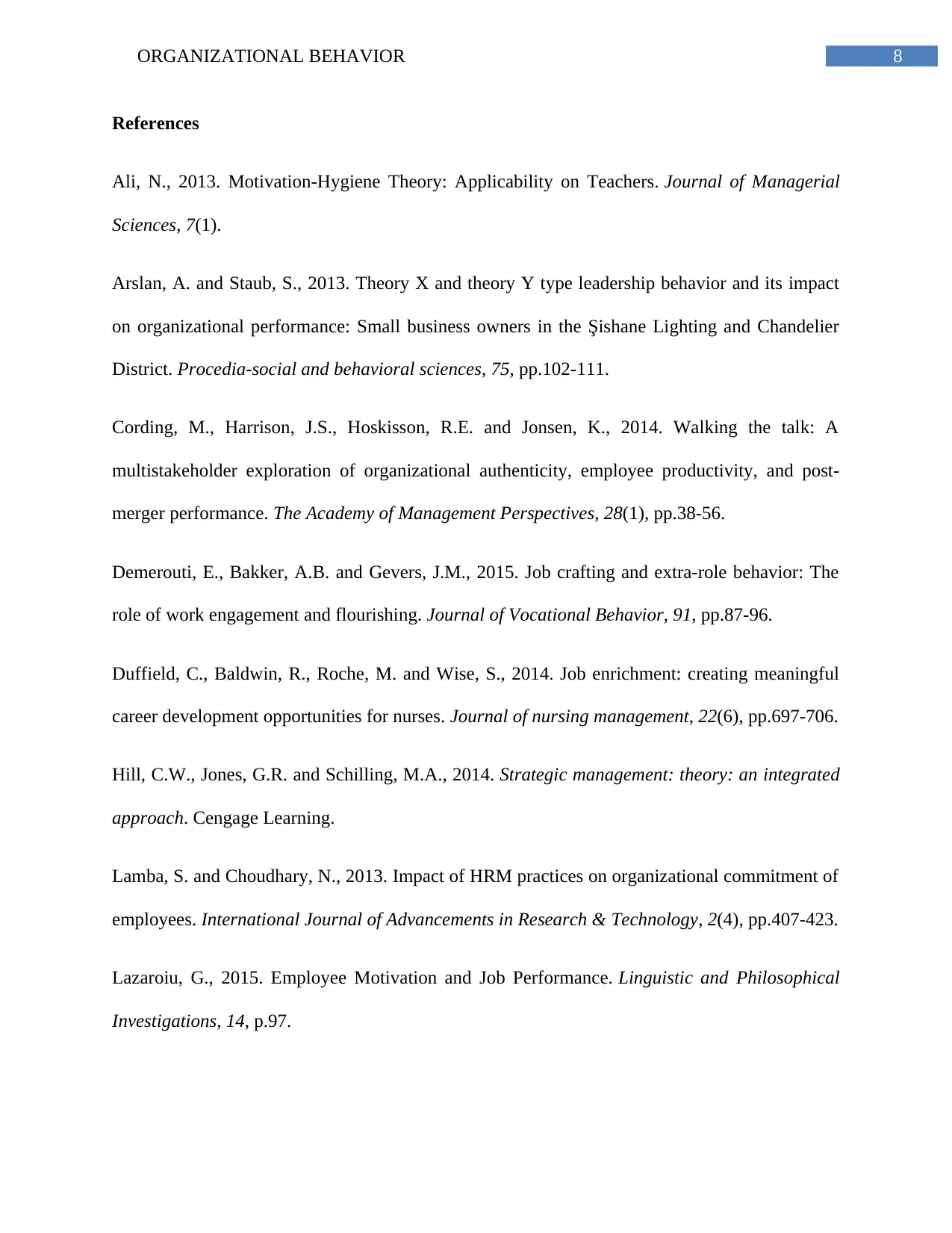
8ORGANIZATIONAL BEHAVIOR
References
Ali, N., 2013. Motivation-Hygiene Theory: Applicability on Teachers. Journal of Managerial
Sciences, 7(1).
Arslan, A. and Staub, S., 2013. Theory X and theory Y type leadership behavior and its impact
on organizational performance: Small business owners in the Şishane Lighting and Chandelier
District. Procedia-social and behavioral sciences, 75, pp.102-111.
Cording, M., Harrison, J.S., Hoskisson, R.E. and Jonsen, K., 2014. Walking the talk: A
multistakeholder exploration of organizational authenticity, employee productivity, and post-
merger performance. The Academy of Management Perspectives, 28(1), pp.38-56.
Demerouti, E., Bakker, A.B. and Gevers, J.M., 2015. Job crafting and extra-role behavior: The
role of work engagement and flourishing. Journal of Vocational Behavior, 91, pp.87-96.
Duffield, C., Baldwin, R., Roche, M. and Wise, S., 2014. Job enrichment: creating meaningful
career development opportunities for nurses. Journal of nursing management, 22(6), pp.697-706.
Hill, C.W., Jones, G.R. and Schilling, M.A., 2014. Strategic management: theory: an integrated
approach. Cengage Learning.
Lamba, S. and Choudhary, N., 2013. Impact of HRM practices on organizational commitment of
employees. International Journal of Advancements in Research & Technology, 2(4), pp.407-423.
Lazaroiu, G., 2015. Employee Motivation and Job Performance. Linguistic and Philosophical
Investigations, 14, p.97.
References
Ali, N., 2013. Motivation-Hygiene Theory: Applicability on Teachers. Journal of Managerial
Sciences, 7(1).
Arslan, A. and Staub, S., 2013. Theory X and theory Y type leadership behavior and its impact
on organizational performance: Small business owners in the Şishane Lighting and Chandelier
District. Procedia-social and behavioral sciences, 75, pp.102-111.
Cording, M., Harrison, J.S., Hoskisson, R.E. and Jonsen, K., 2014. Walking the talk: A
multistakeholder exploration of organizational authenticity, employee productivity, and post-
merger performance. The Academy of Management Perspectives, 28(1), pp.38-56.
Demerouti, E., Bakker, A.B. and Gevers, J.M., 2015. Job crafting and extra-role behavior: The
role of work engagement and flourishing. Journal of Vocational Behavior, 91, pp.87-96.
Duffield, C., Baldwin, R., Roche, M. and Wise, S., 2014. Job enrichment: creating meaningful
career development opportunities for nurses. Journal of nursing management, 22(6), pp.697-706.
Hill, C.W., Jones, G.R. and Schilling, M.A., 2014. Strategic management: theory: an integrated
approach. Cengage Learning.
Lamba, S. and Choudhary, N., 2013. Impact of HRM practices on organizational commitment of
employees. International Journal of Advancements in Research & Technology, 2(4), pp.407-423.
Lazaroiu, G., 2015. Employee Motivation and Job Performance. Linguistic and Philosophical
Investigations, 14, p.97.
⊘ This is a preview!⊘
Do you want full access?
Subscribe today to unlock all pages.

Trusted by 1+ million students worldwide
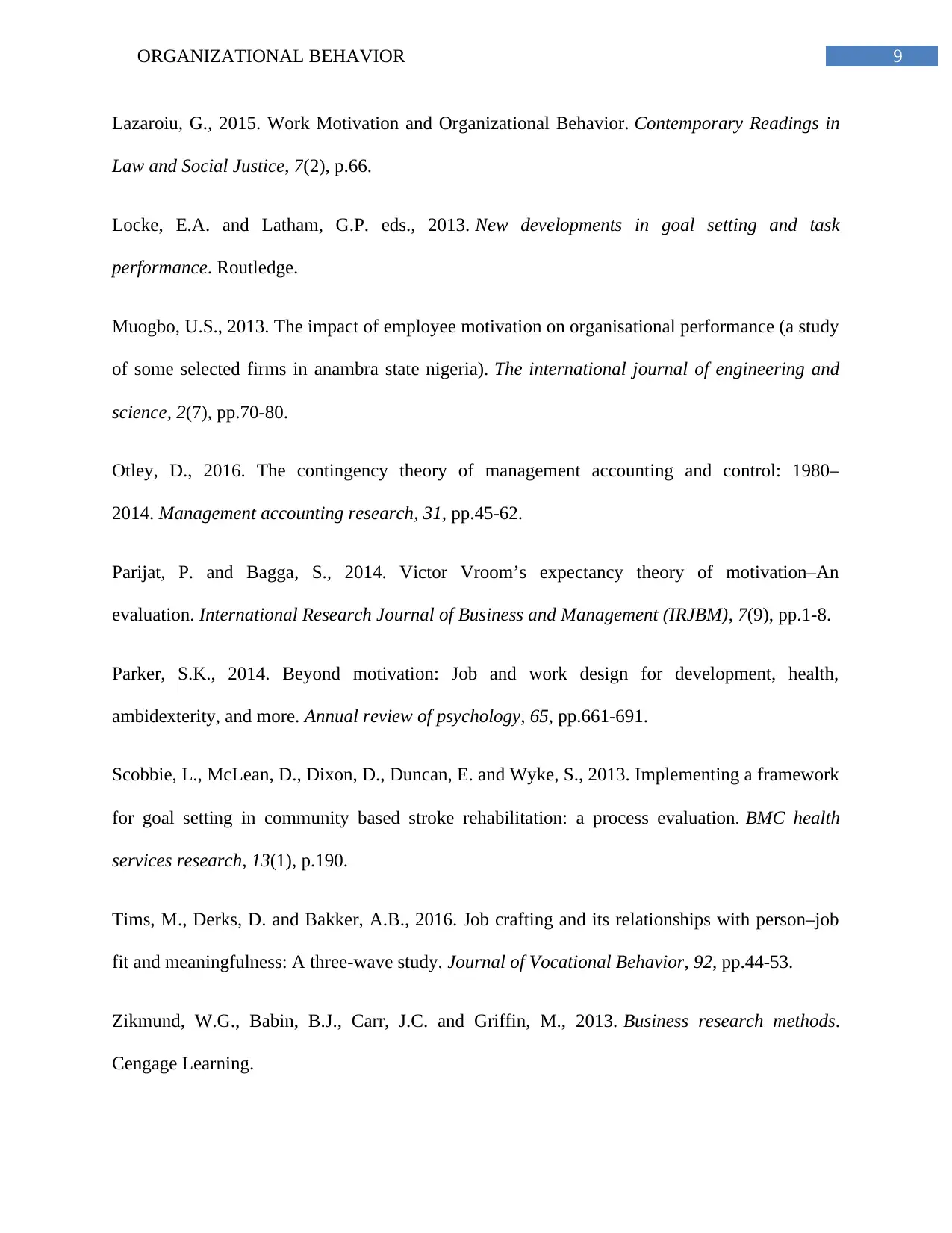
9ORGANIZATIONAL BEHAVIOR
Lazaroiu, G., 2015. Work Motivation and Organizational Behavior. Contemporary Readings in
Law and Social Justice, 7(2), p.66.
Locke, E.A. and Latham, G.P. eds., 2013. New developments in goal setting and task
performance. Routledge.
Muogbo, U.S., 2013. The impact of employee motivation on organisational performance (a study
of some selected firms in anambra state nigeria). The international journal of engineering and
science, 2(7), pp.70-80.
Otley, D., 2016. The contingency theory of management accounting and control: 1980–
2014. Management accounting research, 31, pp.45-62.
Parijat, P. and Bagga, S., 2014. Victor Vroom’s expectancy theory of motivation–An
evaluation. International Research Journal of Business and Management (IRJBM), 7(9), pp.1-8.
Parker, S.K., 2014. Beyond motivation: Job and work design for development, health,
ambidexterity, and more. Annual review of psychology, 65, pp.661-691.
Scobbie, L., McLean, D., Dixon, D., Duncan, E. and Wyke, S., 2013. Implementing a framework
for goal setting in community based stroke rehabilitation: a process evaluation. BMC health
services research, 13(1), p.190.
Tims, M., Derks, D. and Bakker, A.B., 2016. Job crafting and its relationships with person–job
fit and meaningfulness: A three-wave study. Journal of Vocational Behavior, 92, pp.44-53.
Zikmund, W.G., Babin, B.J., Carr, J.C. and Griffin, M., 2013. Business research methods.
Cengage Learning.
Lazaroiu, G., 2015. Work Motivation and Organizational Behavior. Contemporary Readings in
Law and Social Justice, 7(2), p.66.
Locke, E.A. and Latham, G.P. eds., 2013. New developments in goal setting and task
performance. Routledge.
Muogbo, U.S., 2013. The impact of employee motivation on organisational performance (a study
of some selected firms in anambra state nigeria). The international journal of engineering and
science, 2(7), pp.70-80.
Otley, D., 2016. The contingency theory of management accounting and control: 1980–
2014. Management accounting research, 31, pp.45-62.
Parijat, P. and Bagga, S., 2014. Victor Vroom’s expectancy theory of motivation–An
evaluation. International Research Journal of Business and Management (IRJBM), 7(9), pp.1-8.
Parker, S.K., 2014. Beyond motivation: Job and work design for development, health,
ambidexterity, and more. Annual review of psychology, 65, pp.661-691.
Scobbie, L., McLean, D., Dixon, D., Duncan, E. and Wyke, S., 2013. Implementing a framework
for goal setting in community based stroke rehabilitation: a process evaluation. BMC health
services research, 13(1), p.190.
Tims, M., Derks, D. and Bakker, A.B., 2016. Job crafting and its relationships with person–job
fit and meaningfulness: A three-wave study. Journal of Vocational Behavior, 92, pp.44-53.
Zikmund, W.G., Babin, B.J., Carr, J.C. and Griffin, M., 2013. Business research methods.
Cengage Learning.
Paraphrase This Document
Need a fresh take? Get an instant paraphrase of this document with our AI Paraphraser
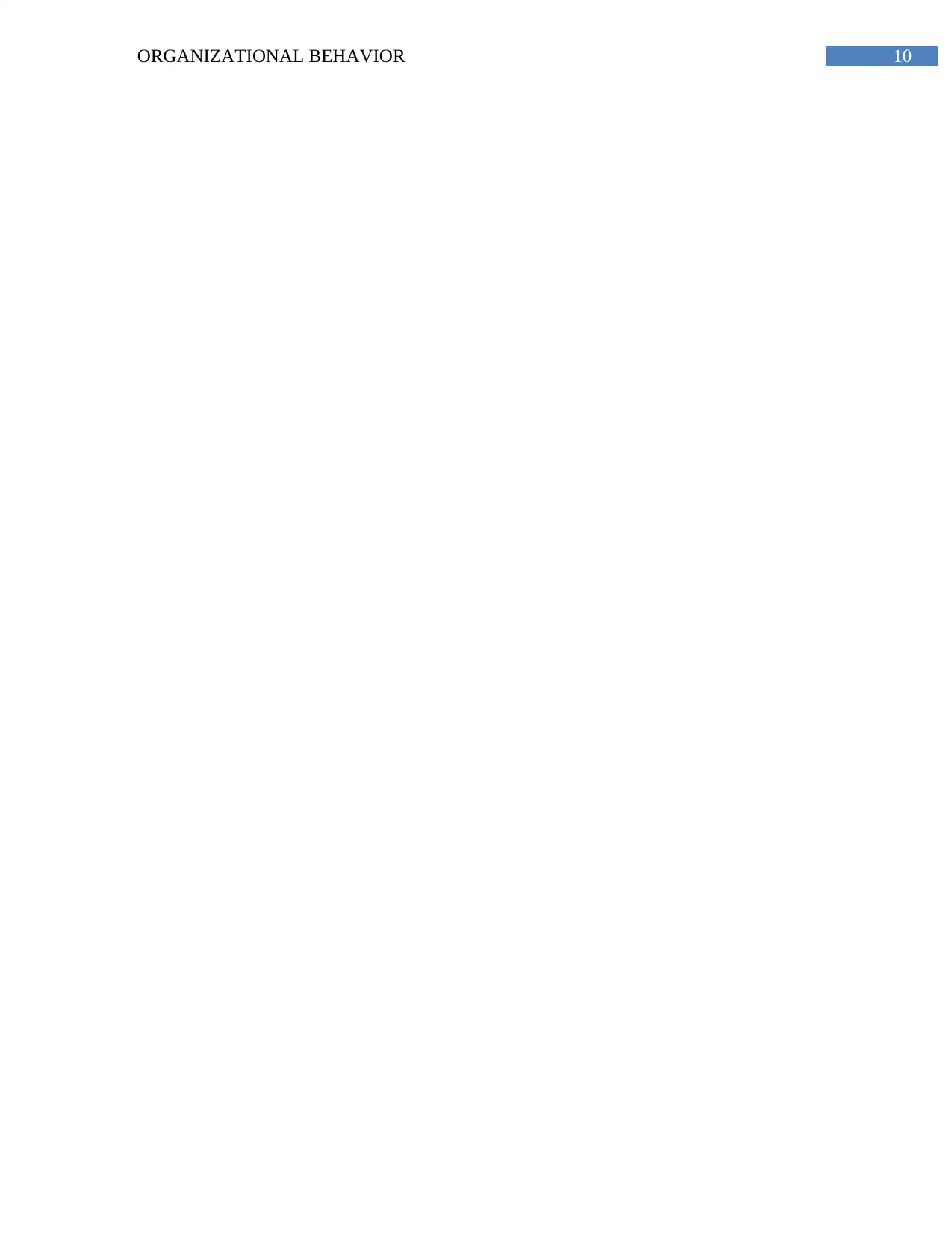
10ORGANIZATIONAL BEHAVIOR
1 out of 11
Related Documents
Your All-in-One AI-Powered Toolkit for Academic Success.
+13062052269
info@desklib.com
Available 24*7 on WhatsApp / Email
![[object Object]](/_next/static/media/star-bottom.7253800d.svg)
Unlock your academic potential
Copyright © 2020–2025 A2Z Services. All Rights Reserved. Developed and managed by ZUCOL.





